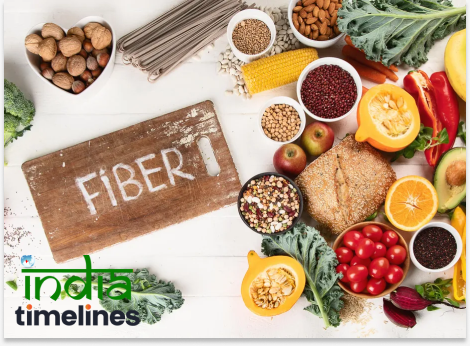
In the quest for better health, fiber often emerges as a crucial component of a balanced diet. Despite being frequently overlooked, fiber plays an essential role in maintaining overall well-being. This indigestible carbohydrate is found in various foods and offers numerous health benefits, from supporting digestive health to aiding in weight management. Let’s explore the top high-fiber foods that can enhance your nutrition and contribute to healthier eating habits.
What is Fiber and Why is it Important?
Fiber is a type of carbohydrate found in plant-based foods that the body cannot digest. Unlike other nutrients, fiber passes through the digestive system relatively intact, providing a range of benefits along the way. There are two main types of dietary fiber: soluble and insoluble.
- Soluble Fiber: Dissolves in water and forms a gel-like substance. It helps lower blood cholesterol levels and stabilize blood sugar levels. Common sources include oats, beans, and apples.
- Insoluble Fiber: Does not dissolve in water and adds bulk to the stool. It aids in preventing constipation and promoting regular bowel movements. Sources include whole grains, nuts, and vegetables.
Incorporating both types of fiber into your diet is essential for optimal health. Here’s a look at some top high-fiber foods that can help you achieve your nutritional goals.
1. Whole Grains
Whole grains are a fantastic source of dietary fiber and other essential nutrients. Unlike refined grains, whole grains retain the bran, germ, and endosperm, providing more fiber and nutrients. Popular whole grains include:
- Oats: Oats are rich in beta-glucan, a type of soluble fiber known for its cholesterol-lowering properties. A bowl of oatmeal can be a heart-healthy breakfast that also keeps you full longer.
- Quinoa: This grain is not only high in fiber but also a complete protein, making it an excellent choice for vegetarians and vegans. It adds a nutty flavor and texture to salads and side dishes.
- Brown Rice: Brown rice retains its bran layer, providing more fiber than white rice. It’s a versatile side dish that pairs well with a variety of meals.
2. Legumes
Legumes, including beans, lentils, and chickpeas, are among the best sources of dietary fiber. They are also packed with protein and essential nutrients, making them a staple in plant-based diets.
- Black Beans: Rich in both soluble and insoluble fiber, black beans help regulate blood sugar levels and support digestive health. They are ideal for soups, salads, and chili.
- Lentils: Lentils are not only high in fiber but also in protein and iron. They cook quickly and can be used in soups, stews, or as a meat substitute in various dishes.
- Chickpeas: Also known as garbanzo beans, chickpeas are high in fiber and protein. They are the main ingredient in hummus and can be added to salads or roasted for a crunchy snack.
3. Vegetables
Vegetables are an excellent source of fiber, vitamins, and minerals. They are low in calories and high in nutrients, making them a key component of a healthy diet.
- Broccoli: Broccoli is high in fiber and contains a variety of vitamins and minerals, including vitamin C, vitamin K, and folate. It can be enjoyed steamed, roasted, or raw.
- Carrots: Carrots are rich in both soluble and insoluble fiber. They are also high in beta-carotene, which supports eye health. Enjoy them raw, in salads, or cooked as a side dish.
- Sweet Potatoes: Sweet potatoes are a nutrient-dense source of fiber and are high in vitamins A and C. They are versatile and can be baked, mashed, or added to soups.
4. Fruits
Fruits are not only delicious but also provide a significant amount of dietary fiber. They are an excellent way to satisfy a sweet tooth while boosting your fiber intake.
- Apples: Apples are a great source of soluble fiber, particularly pectin. Eating them with the skin on maximizes their fiber content. Enjoy them as a snack or in salads.
- Pears: Pears are high in fiber and can help promote feelings of fullness. They are great eaten fresh, added to yogurt, or baked for a healthy dessert.
- Berries: Berries such as raspberries, blackberries, and strawberries are packed with fiber and antioxidants. They make a nutritious addition to smoothies, yogurt, or oatmeal.
5. Nuts and Seeds
Nuts and seeds are nutrient-dense and provide a good source of fiber, healthy fats, and protein. They are a satisfying and heart-healthy snack option.
- Chia Seeds: Chia seeds are an exceptional source of fiber, with both soluble and insoluble types. They are also rich in omega-3 fatty acids. Add them to smoothies, yogurt, or make chia pudding.
- Flaxseeds: Flaxseeds are high in fiber and alpha-linolenic acid (ALA), a type of omega-3 fatty acid. Ground flaxseeds can be added to smoothies, cereals, or used in baking.
- Almonds: Almonds provide a substantial amount of fiber along with healthy fats and protein. They are great as a snack, in salads, or as almond butter.
6. Whole Grain Bread and Pasta
Whole grain breads and pastas are healthier alternatives to their refined counterparts, providing additional fiber and nutrients.
- Whole Wheat Bread: Whole wheat bread contains more fiber than white bread, helping to keep you full and satisfied. Look for 100% whole wheat or whole grain varieties.
- Whole Grain Pasta: Whole grain pasta is higher in fiber and nutrients compared to regular pasta. It can be used in a variety of dishes, from pasta salads to hearty dinners.
7. Avocados
Avocados are not only rich in healthy fats but also a good source of fiber. They provide a creamy texture to dishes and are versatile in many recipes.
- Health Benefits: The fiber in avocados supports digestive health and helps maintain steady blood sugar levels. They are also high in potassium, which helps regulate blood pressure.
- How to Enjoy: Add avocado slices to salads, spread them on toast, or use them as a base for creamy sauces and dressings.
8. Popcorn
Popcorn is a whole grain and can be a healthy, high-fiber snack when prepared correctly.
- Health Benefits: Air-popped popcorn is high in fiber and low in calories, making it a great option for satisfying cravings without adding excessive calories. Avoid excessive butter and salt for a healthier snack.
- How to Enjoy: Season with herbs or nutritional yeast for added flavor without the extra calories.
9. Barley
Barley is a whole grain with a chewy texture and nutty flavor. It’s an excellent source of soluble fiber, particularly beta-glucan.
- Health Benefits: Barley helps lower cholesterol levels, regulate blood sugar, and promote digestive health. It can be used in soups, salads, or as a side dish.
- How to Enjoy: Use barley as a base for grain salads, add it to soups and stews, or use it as a substitute for rice.
10. Artichokes
Artichokes are a lesser-known but highly nutritious vegetable packed with fiber and antioxidants.
- Health Benefits: Artichokes are rich in both soluble and insoluble fiber, aiding in digestive health and maintaining a healthy gut microbiome. They are also high in vitamins C and K.
- How to Enjoy: Steam or roast artichokes, and serve them with a healthy dip or add them to salads.
Incorporating High-Fiber Foods into Your Diet
To reap the benefits of high-fiber foods, aim to include a variety of these options in your daily meals. Here are some tips for incorporating them into your diet:
- Start Gradually: If you’re not used to consuming a lot of fiber, increase your intake gradually to avoid digestive discomfort.
- Combine Fiber Sources: Combine different high-fiber foods in your meals. For example, have a salad with beans and a side of quinoa.
- Stay Hydrated: Drink plenty of water to help fiber move through your digestive system smoothly.
- Experiment with Recipes: Try new recipes that include high-fiber ingredients, such as whole grain dishes, bean-based stews, or veggie-packed soups.
Conclusion
High-fiber foods are essential for a balanced and healthy diet. They support digestive health, aid in weight management, and provide a range of other health benefits. By incorporating a variety of these foods into your meals, you can improve your overall nutrition and contribute to your long-term well-being. So, next time you’re planning your meals, consider adding some of these high-fiber foods to your shopping list. Your body will thank you for it!





























trezor.io/start
trezor.io/start